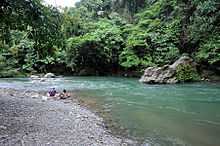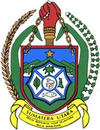North Sumatra
| North Sumatra Sumatera Utara | |||
|---|---|---|---|
| Province | |||
|
Istana Maimun, Medan | |||
| |||
| Motto: Marsipature hutana be (Batak) | |||
 Location of North Sumatra in Indonesia | |||
| Coordinates: 2°00′N 99°00′E / 2.000°N 99.000°ECoordinates: 2°00′N 99°00′E / 2.000°N 99.000°E | |||
| Country | Indonesia | ||
| Capital | Medan | ||
| Government | |||
| • Governor | Gatot Pudjo Nugroho (PKS) | ||
| • Vice Governor | Tengku Erry Nuradi | ||
| Area | |||
| • Total | 72,981.23 km2 (28,178.21 sq mi) | ||
| Population (2014) | |||
| • Total | 13,527,937 | ||
| • Density | 190/km2 (480/sq mi) | ||
| Demographics | |||
| • Ethnic groups |
Batak (40.95%) (Karo, Pakpak, Simalungun, Batak Toba, Angkola, Mandailing) Javanese (24.62%) Chinese (8.76%) Malay (5.80%) Nias (4.42%) Minangkabau (1.66%) Acehnese (0.97%) other (9,72%)[1] | ||
| • Religion | Islam (64.5%), Christianity (30.4%), Buddhism (6.8%), Hindu (0,2%) | ||
| • Languages | Indonesian, Malay, Karo, Pakpak, Simalungun, Batak Toba, Angkola, Mandailing, Chinese, Medan Hokkien | ||
| Time zone | WIB (UTC+7) | ||
| Website | sumutprov.go.id | ||
North Sumatra (Indonesian: Sumatera Utara) is a province of Indonesia. It is located on the island of Sumatra, and its capital is Medan. It is the most populous Indonesian province outside of Java, with over 13½ million inhabitants in 2014.[2]
Geography and population

The province of North Sumatra stretches across the island of Sumatra between the Indian Ocean and the Strait Malacca. It borders Aceh province on the northwest and Riau and West Sumatra provinces in the southeast. It has an area of 72,981 km². The province contains a broad, low plain along the Strait of Malacca on which the provincial capital, Medan, is located. In the south and west, the land rises to the mountain range that runs the length of Sumatra; the mountains here are dominated by Lake Toba, formed from the caldera of an ancient volcano. Several large islands in the Indian Ocean off the west coast of Sumatra are currently part of North Sumatra, most notably Nias Island and the Batu Islands.
North Sumatra recorded a population of 12,985,075 in the 2010 national census, with a sex ratio of 99.59 men per 100 women.[3] The latest estimate (for January 2014) is 13,527,937.[2]
| Historical population | ||
|---|---|---|
| Year | Pop. | ±% |
| 1971 | 6,621,831 | — |
| 1980 | 8,360,894 | +26.3% |
| 1990 | 10,256,027 | +22.7% |
| 1995 | 11,114,667 | +8.4% |
| 2000 | 11,649,655 | +4.8% |
| 2010 | 12,982,204 | +11.4% |
| 2014 | 13,527,937 | +4.2% |
| Source: Badan Pusat Statistik 2010 | ||
Administrative divisions




North Sumatra is currently subdivided into 25 regencies and 8 autonomous cities, listed below with their (provisional) populations at the 2010 Census and according to the latest (2014) estimates. With proposals under consideration to create three additional provinces from parts of the present North Sumatra, these are grouped below according to the putative new province in which they are situated:
Nias Island Region
| Name | Area (km2) | Population Census 2010[4] | Population Estimate January 2014[2] | Capital |
|---|---|---|---|---|
| Gunungsitoli City | 230.80 | 125,566 | 131,507 | Gunungsitoli |
| Nias Regency | 3,495.39 | 132,329 | 136,900 | Gunungsitoli |
| North Nias Regency (Nias Utara) | 1,202.78 | 127,530 | 132,593 | Lotu |
| South Nias Regency (Nias Selatan) | 1,625.91 | 289,876 | 301,886 | Teluk Dalam |
| West Nias Regency (Nias Barat) | # | 81,461 | 85,246 | Lahomi |
- # the area of West Nias Regency is included in the figure for Nias Regency.
Southeast Sumatra Region
| Name | Area (km2) | Population Census 2010 | Population Estimate January 2014[2] | Capital |
|---|---|---|---|---|
| Padang Sidempuan City | 114.65 | 191,554 | 199,582 | Padang Sidempuan |
| Mandailing Natal Regency | 6,620.70 | 403,894 | 421,968 | Panyabungan |
| North Padang Lawas Regency (Padang Lawas Utara) | 3,918.05 | 223,049 | 232,928 | Gunung Tua |
| Padang Lawas Regency | 3,892.74 | 223,480 | 234,728 | Sibuhuan |
| South Tapanuli Regency (Tapanuli Selatan) | 4,352.86 | 264,108 | 274,905 | Sipirok |
Tapanuli Region
| Name | Area (km2) | Population Census 2010 | Population Estimate January 2014[2] | Capital |
|---|---|---|---|---|
| Sibolga City | 10.77 | 84,444 | 88,032 | Sibolga |
| Central Tapanuli Regency (Tapanuli Tengah) | 2,158.00 | 310,962 | 324,315 | Pandan |
| Humbang Hasundutan Regency | 2,297.20 | 171,687 | 178,866 | Dolok Sanggul |
| North Tapanuli Regency (Tapanuli Utara) | 3,764.65 | 278,897 | 290,996 | Tarutung |
| Samosir Regency | 2,433.50 | 111,650 | 124,683 | Pangururan |
| Toba Samosir Regency | 2,352.35 | 172,933 | 180,407 | Balige |
East Sumatra Region
| Name | Area (km2) | Population Census 2010 | Population Estimate January 2014[2] | Capital |
|---|---|---|---|---|
| Binjai City | 90.24 | 246,010 | 256,502 | Binjai |
| Medan City | 265.10 | 2,109,339 | 2,185,789 | Medan |
| Pematang Siantar City | 79.87 | 234,885 | 244,564 | Pematang Siantar |
| Tanjung Balai City | * | 154,426 | 160,941 | Tanjung Balai |
| Tebing Tinggi City | 38.44 | 145,180 | 151,354 | Tebing Tinggi |
| Asahan Regency | 3,675.79 | 667,563 | 696,364 | Kisaran |
| Batubara Regency | 904.96 | 374,535 | 391,686 | Limapuluh |
| Dairi Regency | 1,927.80 | 269,848 | 281,405 | Sidikalang |
| Deli Serdang Regency | 2,486.14 | 1,789,243 | 1,865,695 | Lubukpakam |
| Karo Regency | 2,127.25 | 350,479 | 365,713 | Kabanjahe |
| Labuhan Batu Regency | 9,223.18 | 414,417 | 432,560 | Rantau Prapat |
| Langkat Regency | 6,263.29 | 966,133 | 1,008,207 | Stabat |
| North Labuhan Batu Regency (Labuhan Batu Utara) | # | 331,660 | 344,603 | Aek Kanopan |
| Pakpak Bharat Regency | 1,218.30 | 40,481 | 42,208 | Salak |
| Serdang Bedagai Regency | 1,913.33 | 592,922 | 619,367 | Sei Rampah |
| Simalungun Regency | 4,386.60 | 818,104 | 852,095 | Raya |
| South Labuhan Batu Regency (Labuhan Batu Selatan) | # | 277,549 | 289,346 | Kota Pinang |
- * the area of Tanjung Balai city is included in the figure for Asahan Regency, from which it was carved out in 2007.
- # the areas of North Labuhan Batu Regency and South Labuhan Batu Regency are included in the figure for Labuhan Batu Regency, from which they were carved out in 2007.
Proposed new provinces
All parties in the North Sumatra legislative council have agreed to the formation of a new Tapanuli Province, a new Southeast Sumatra Province and a new Nias Island Province. This has been approved at a regional plenary session on 2 May 2011, but still needs approval from Central government which has not yet enacted the grand design for additional provinces.[5][6]
Under the proposals, the new Tapanuli province would comprise five disadvantaged regencies in western North Sumatra with majority Christian Bataknese populations: Humbang Hasundutan, Toba Samosir, Tapanuli Utara (North Tapanuli), Tapanuli Tengah (Central Tapanuli) and Samosir - together with the municipality (city) of Sibolga.[7]
The proposed Southeast Sumatra province would comprise four disadvantaged regencies with majority Muslim Bataknese Angkola populations - Tapanuli Selatan (South Tapanuli), Mandailing Natal, Padang Lawas and Padang Lawas Utara (North Padang Lawas) - together with the municipality (city) of Padang Sidempuan.[7]
The proposed Nias Island province would consist of the remote Christian-majority regencies of Nias, Nias Utara (North Nias), Nias Barat (West Nias) and Nias Selatan (South Nias) - together with the municipality (city) of Gunungsitoli - all on the island of Nias.[7] Nias Selatan Regency includes the smaller Batu Islands (Pulau-pulau Batu) to the south, lying between Nias and Siberut.
The remaining regencies and cities currently within North Sumatra province would comprise the residual area, which might be renamed East Sumatra (Sumatera Timur).
Agriculture and economy
Sumatra Mandheling and Sumatra Lintong coffee beans are grown in North Sumatra and largely exported to the United States. Mandheling is named after the similarly spelt Mandailing people located in North Sumatra, Indonesia. The name is the result of a misunderstanding by the first foreign purchaser of the variety, and no coffee is actually produced in the "Mandailing region". Lintong on the other hand, is named after the Lintong district, also located in North Sumatra.
Tourism


Besides Lake Toba and Orang Utan conservatory at Bukit Lawang there are also Taman Hutan Raya at Berastagi which declared by Keputusan Presiden RI Nomor 48 Tahun 1998 tanggal 19 November 1998.
Airports
The modern Kuala Namu International Airport is opened in July 25, 2013 and located almost 40 kilometers from Medan. The airport replaces the old Polonia International Airport.[8]
Polonia International Airport (Indonesian: Bandar Udara Internasional Polonia) (IATA: MES, ICAO: WIMM) (popularly Polonia Airport, as in Indonesia, Bandara Polonia) is located about 5 km from the Central Business District of Medan. It is the first international airport in Medan, although the airport is under airforce authority. Polonia airport is the site of several crashes, is inappropriately located in the center of the city of Medan, has a difficult takeoff path and has a short runway. It serves flights to several Indonesian and Malaysian cities, along with a flight to Singapore and Thailand. Flights to Indian cities are also planned. In terms of passenger numbers, Polonia is the fourth largest airport in Indonesia.
Seaports
North Sumatra has an international seaport at Belawan, near Medan and is now preparing to have a new seaport at Kuala Tanjung, in Batubara Regency, for about Rp.1 trillion ($114 million) budget.[9]
Sei Mangkei Industrial Area
Sei Mangkei Industrial Area is known also as Sei Mangkei - Integrated Sustainable Palm Oil Cluster (SM-ISPOIC); it is located in Simalungun Regency and was formally opened on 12 June 2010. Four companies have joined in this area, with investment costs totalling up to Rp1.5 trillion ($176 million).[10][11] In April 2011, three other companies also joined in the Sei Mangkei area. They are Procter & Gamble Co for making CPO derivatives of cosmetic raw materials, Ferrostaal AG and Fratelli Gianazza SpA.
References
- ↑ Indonesia's Population: Ethnicity and Religion in a Changing Political Landscape. Institute of Southeast Asian Studies. 2003.
- ↑ 2.0 2.1 2.2 2.3 2.4 2.5 http://www.depkes.go.id/downloads/Penduduk%20Kab%20Kota%20Umur%20Tunggal%202014.pdf Estimasi Penduduk Menurut Umur Tunggal Dan Jenis Kelamin 2014 Kementerian Kesehatan
- ↑ Account Suspended
- ↑ Biro Pusat Statistik, Jakarta, 2011.
- ↑ N. Sumatra to have two new provinces | The Jakarta Post
- ↑ http://waspada.co.id/index.php?option=com_content&view=article&id=193401:sibolga-rejects-included-in-new-province-of-tapanuli&catid=30:english-news&Itemid=101
- ↑ 7.0 7.1 7.2 Support for N. Sumatra division into 4 provinces | The Jakarta Post
- ↑ "Roda Empat Disediakan Menuju Bandara Kuala Namu". July 23, 2013.
- ↑ http://waspada.co.id/index.php?option=com_content&view=article&id=181542:n-sumatra-to-have-new-seaport&catid=30:english-news&Itemid=101
- ↑ Four Firms to Invest Rp1.5 Trln in Sei Mangkei Industrial Area, Sumatera
- ↑ Jurnas.com
External links
| Wikimedia Commons has media related to North Sumatra. |
| ||||||||||||||||||||||||||||||
.jpg)

